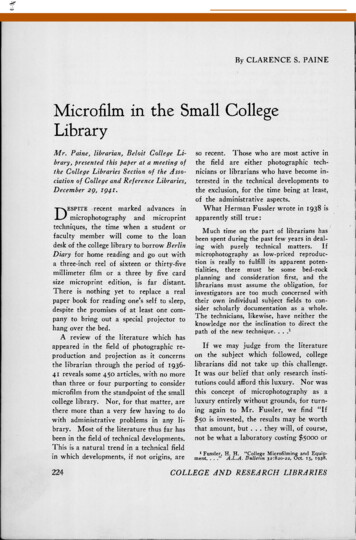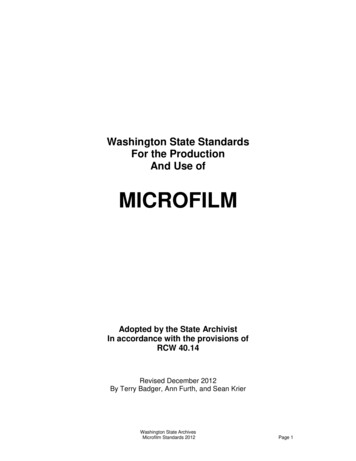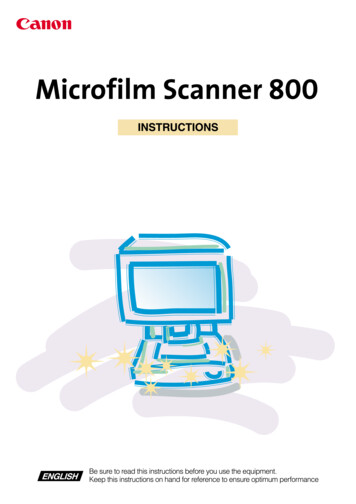
Transcription
orAccesscitationtoLearningandandBy C L A R E N C E S. P A I N EMicrofilm in the Small CollegeLibraryMr. Paine, librarian, Beloit College Library, presented this paper at a meeting ofthe College Libraries Section of the Association of College and Reference Libraries,December 29, 1941.recent marked advances inmicrophotography and microprinttechniques, the time when a student orfaculty member will come to the loandesk of the college library to borrow BerlinDiary for home reading and go out witha three-inch reel of sixteen or thirty-fivemillimeter film or a three by five cardsize microprint edition, is far distant.There is nothing yet to replace a realpaper book for reading one's self to sleep,despite the promises of at least one company to bring out a special projector tohang over the bed.ESPITEDA review of the literature which hasappeared in the field of photographic reproduction and projection as it concernsthe librarian through the period of 193641 reveals some 450 articles, with no morethan three or four purporting to considermicrofilm from the standpoint of the smallcollege library. Nor, for that matter, arethere more than a very few having to dowith administrative problems in any library. Most of the literature thus far hasbeen in the field of technical developments.This is a natural trend in a technical fieldin which developments, if not origins, are224so recent. Those who are most active inthe field are either photographic technicians or librarians who have become interested in the technical developments tothe exclusion, for the time being at least,of the administrative aspects.W h a t Herman Fussier wrote in 1938 isapparently still true:Much time on the part of librarians hasbeen spent during the past few years in dealing with purely technical matters.Ifmicrophotography as low-priced reproduction is really to fulfill its apparent potentialities, there must be some bed-rockplanning and consideration first, and thelibrarians must assume the obligation, forinvestigators are too much concerned withtheir own individual subject fields to consider scholarly documentation as a whole.The technicians, likewise, have neither theknowledge nor the inclination to direct thepath of the new technique. . .If we may judge from the literatureon the subject which followed, collegelibrarians did not take up this challenge.It was our belief that only research institutions could afford this luxury. Nor wasthis concept of microphotography as aluxury entirely without grounds, for turning again to M r . Fussier, we find "If 50 is invested, the results may be worththat amount, but . . . they will, of course,not be what a laboratory costing 5000 or1 Fussier, H. H.ment. . . . " A.L.A.C O L L E G E , AND"College Microfilming and EquipBulletin 32:820-22, Oct. 15, 1938.RESEARCHLIBRARIESsimilarScholarsh
more can produce." 2 As if this mentionof some figure lying vaguely between 50and 5000 were not sufficient to frightenany budget-conscious college librarian, M r .Fussier goes on to list cameras with supplementary lens, home-rigged copyingstand, developing tank, hand viewer orsemi-home-rigged projector, and a fewaccessories such as bottles, safe light, balance, a graduate, fifty-foot capacity reels,three mixing tanks, Stineman reels, printers, enlargers, splicers, rewinders, etc.This was the technician, trying valiantlyto interest the college librarian in embarking upon a microfilm program in his library. No one has contributed more totechnical knowledge of microphotographyfor libraries than M r . Fussier, but apparently the information which he has givenus has fallen upon deaf ears.Recognition for the College LibraryOf the few authorities on college libraryadministration who have produced bookson that subject during this five-year period,Miss McCrum, in 1937, is the only onewho, to my knowledge, has granted microphotography any recognition as a legitimate part of the college library. 3For the most part, in the literature ofcollege librarianship and microphotographythere are to be found only a few highsounding generalities such as "For as thegift of Gutenberg brought many bookswithin the reach of many men, so any bookmay come to any library through themedium of the microphotograph."T h e chief difficulty seems to have beenthe belief that microphotography and theuse of microfilm were inseparable. Of the2 Fussier, H. H."Microphotography for SmallerLibraries." A.L.A.Bulletin 31:41-42, Jan. 1937.3 McCrum, B. P.An Estimate of Standards for aCollege Library.Journalism Laboratory Press, 1937,P. 132.JUNE j 1942former it has been said, "Reproduction ofsuch material on request is, of course, selfsupporting and therefore not a liability tothe library but a definite asset to prestige."That it would be the latter I do not doubt,but considering the small volume of suchreproduction which would be called forfrom the average college library and thatthe original cost of the reproduction equipment and laboratory must be amortized,the field of microphotography is not onein which any of us can afford to indulge—to charge off an expenditure of severalthousand dollars, or even several hundred,to the prestige account is apt to bring theauditors on the run.Separation of MicrophotographyMicrofilmandEven Miss McCrum failed to recognizethat microphotography and the use ofmicrofilm can be separated insofar aslibrary administration is concerned. Inthe "checklist of building requirements"which she appended to her book, there isno entry under microfilm, but undermicrophotography we find ". . . Space andequipment for making and using film andphotostats.Plumbing for developingroom. Provide for growth in this department."More fanciful authors have gone so faras to suggest to the college librarian thefilming of the card catalog as economy ofspace and insurance against loss by fire orflood. Even at a minimum cost of onehalf cent per card, this would seem to berather expensive insurance when we figurethe chances of destruction of the cardcatalog, by these or other means, especiallywhen the film copy would be out-datedbefore it was ever completed. Moreover,recent experiments and developments ina microphotographic charging system,225
though undoubtedly practical in some situations, are not steps which the averagecollege library can justify.Such schemes, along with the failure ofmost authorities to distinguish betweenmicrophotography, with its expensiveequipment and laboratories, and the useof microfilm, have undoubtedly beenmajor factors in the college librarians' apparent failure to recognize the potentialplace of film as a solution to at least someof their administrative problems.In this paper I do not propose to assumeany psychic powers in order to tell youwhat your problem is and how microfilmcan solve it. No one but you can pretendto understand your immediate problemsor propose their solution. Neither can Itell you all about microfilm and its reading equipment; and, if I could, it wouldbe useless duplication of literature alreadyin existence, from the hands of more competent authorities. M y purpose shall beonly to state one problem of library administration and, by presenting alternativesolutions, to demonstrate that under certain conditions microfilm has a place in thecollege library.NewspapersBriefly stated, the problem is newspapers. Our files comprise the local papers, including the college paper, from1847 to date, and the New York Timesfrom 1913 to date. A t least half are pulppaper. As in all such collections, theproblem is inherently twofold; namely,the prevention of deterioration of the paperstock itself and the provision of adequateand accessible storage and reading roomspace.T h e traditional solution of the firstphase of the problem would be the preservation of the originals by some process,226varying from the covering with Japanesetissue at a cost of seven or eight cents persheet, to lamination with cellulose acetateat a cost of about fifteen to twenty centsper sheet. W i t h an estimated minimum of175,000 pages, or 87,500 sheets, in the filesof the local newspapers alone, the immediate cost to be anticipated would rangefrom 6125 to 17,400. These figures donot take into consideration the rebindingcosts and the added storage space necessitated by the increased bulk resulting fromany known preservative process. Nor arewe, for the moment, even consideringthe overwhelming task of taking any stepstoward processing the New York Times,1913 to date.In the second phase of our problem, weare confronted with an estimated total of6250 cubic feet tied up in newspaper files,traffic, and reading room space, with allavailable shelf and building space alreadyoccupied.Space RequirementsT h e New York Times and our localnewspapers in bound form require thirtyfive cubic feet of shelf space annually. T oprovide adequate shelving and traffic spaceat this rate of expansion for a period oftwenty-five years would require the immediate addition to our building of a roomfifteen by twenty feet at an estimated costof 3000, or 1 per cubic foot—and thiswithout any regard to architectural continuity. Shelving would cost from 1000to 2000, depending upon whether ordinary steel storage or roller type were purchased.Summarizing briefly, if the foregoingsolution were adopted, including processing of the local papers and the provisionof building space and shelving for the nexttwenty-five years, an immediate expendi-C O L L E G E , ANDRESEARCHLIBRARIES
ture of 10,125 to 22,400 would haveto be made.Ij; J]Microfilm presents the only alternativesolution. It is with the adequacy andeconomy of this alternative that the remainder of this paper is concerned.T h e first question with which we areconfronted is that of the durability ofmicrofilm. W e know that the new safetymicrofilm is less subject to destruction byfire than is paper, in that the former willburn only so long as it is in contact withflame from another source. It is obviousthat it is easier to provide fireproof storage for film than for the originals, whichmight require as much as 98 per cent morespace. W e are reasonably sure, accordingto the U.S. Bureau of Standards,4 that,stored under proper conditions of humidity, cellulose acetate ("safety") microfilmcan be expected to last as long as the bestrag paper.Legality of Film CopiesAnother question pertaining to filmcopies to which we must give some thoughtis that of the legality of such copies; inother words, are materials on microfilm4 U.S.B u r e a u of Standards.MiscellaneousPublication M162.W a s h i n g t o n , S u p e r i n t e n d e n t of D o c u ments, 1939.A f e w interested persons, a m o n g them D r . JosephB r o a d m a n , have taken exception to the B u r e a u ofS t a n d a r d s ' report.T h e bone of contention, brieflystated, is that the bureau, while maintaining thatnitrates in films are h a r m f u l , has at the same timepublished the above findings as to the p e r m a n e n c y ofcellulose acetate film in w h i c h some traces of nitratesare to be found. I n concluding, D r . B r o a d m a n goeson to ask, " . . . I s the P a p e r Section of the B u r e a uof S t a n d a r d s t r u l y an a g e n c y f o r the standardization[ o f ] scientific facts or m e r e l y a s e r v a n t f o r the bigfilm c o m p a n i e s ?O r is the b u r e a u m e r e l y t r y i n g tomake the best of a bad situation since so m a n y institutions, and e v e n the U n i t e d S t a t e s g o v e r n m e n t , h a v ei n v e s t e d large sums infilms?"I do not w i s h tominimize the possible significance of the questionw h i c h has been raised by D r . B r o a d m a n , w h o is himself the i n v e n t o r and producer on a commercial basisof a process of paper p r e s e r v a t i o n which is not withoutmerit.T h i s is p r i m a r i l y a question, h o w e v e r , f o rtechnicians. I n the m e a n t i m e w e c a n at least be surethat, u n d e r proper storage conditions, our microfilmcopies will outlast our old pulp paper, and should oursuccessors d i s c o v e r that the films w e r e deteriorating,new positives could be made at a m i n i m u m cost.JUNE j 1942preserved or merely reproduced? In thefilming of certain types of material, especially those which might conceivablybe referred to for legal purposes such asbusiness records, vital statistics, or otherarchival and primary source materials, theadmissibility of such copies as evidence,in the absence of the original document,has been considered. In an opinion handeddown by the United States Court of Appeals in the case of the United States ofAmerica, Plaintiff, vs Martin T . Mantonand George M . Spector, Defendants, itwas held that such photographic records(in this case, of cancelled checks) constitute not secondary but primary evidenceas proof of payment.5 This does notmean that there remains no further question of the legality of film copies, but asfar as newspapers and perhaps other materials in the library are concerned, therewould seem to be no reason for hesitationin discarding the originals for film copiesin the interests of more efficient storageand preservation.Having concluded that microfilm offered the legitimate medium for the preservation of newspaper files, our next problemwas one of sources and costs of photography. Several alternatives were immediately apparent. First, the library mightpurchase outright or rent the necessaryequipment from the Recordak Corporationand employ an operator. Second, a contract could be entered into with the Eastman subsidiary, under which the librarywould ship the materials to be photographed to the company's plant, where allof the work would be done. Third, wemight find a professional operator properlyequipped for microphotography and nearenough to make it possible to set up a0 "Legalityof M i c r o - F i l m R e c o r d s . "JournalDocumentaryReproduction3:79-80, M a r . 1940.of22 7
camera in our building, or to whom wecould get the materials to be filmed without elaborate packing and high transportation costs. Obviously, the criteria forchoosing from the above methods must bethe quality of work obtainable and costs.First MethodDiscardedT h e first of these methods was discardedbecause to amortize equipment costs wouldhave raised the price of filming to a figurein excess of that received on bids from thecommercial sources.In addition, if alibrary undertakes to do its own filming,it must assume the responsibility for goodcopies. And the statement of the Recordak Corporation that it takes little orno experience to take microfilm picturesbecause the experience has been built intothe equipment itself is only applicable infilming uniform materials in which thereis no variation in the size or type of paperand the intensity of the impression fromone sheet to the next. One authority hassaid "the reproduction or the control oftone values is as important in copying asit is in pictorial photography." 6 Y o u willnever realize this so well as when you haveobtained a poor film copy of some longsought bit of source material.As for the costs and quality of workto be expected from either of the commercial sources, we discovered that therewas no appreciable difference between thetwo, and the deciding factor was purelythat of convenience. Costs will be foundto vary with the volume of work to bedone and type of material to be photographed. For the filming of our localnewspaper files a figure of two and onehalf cents per page, or a maximum of0 Townsend, Agnes.nal of Documentary1938.228" F i l m Characteristics." JourReproductioni :346-53, Fall 4375 was estimated. This represents asaving of not less than 30 per cent overthe cheapest possible preservation by anyother means, and instead of an increasein bulk, would permit a 98 per cent reduction over the storage space now required.So far as the current and future files ofthe New York Times and the local paperare concerned, if obtained on film, theimmediate need for an addition to ourbuilding would be obviated.Requisite Reading and Storage EquipmentBut microfilm of any material in thelibrary makes requisite certain reading andstorage equipment. Investigations in thisdirection led us to the conclusion thatthere was only one satisfactory all-purposereading machine with the necessary simplicity of operation for library usage. Irefer to the Recordak Library FilmReader, Model C, at a price of 380,equipped with writing table. T h e superiority of this machine, except for readingshort strips of film not on reels, is soobvious that we will not discuss it furtherhere, except to warn that, if you plan toembark upon any extensive use of microfilm in your library, you must have amachine so easily operated as not to discourage patrons in their use of it.T o assure the greatest degree of permanency of microfilm, it must be stored underconditions of a constant humidity from 50to 52 per cent. For this purpose there aretwo competitive steel filing cabinets on themarket today; one, at a cost of 125, theother, at a cost of 167.50. T h e first ofthese depends for its humidity controlupon an asbestos block to which water isadded when the humidity gauge on theoutside drops below 50 per cent. T h emore expensive of the cabinets, manufactured by Remington Rand, appears to beC O L L E G E , ANDRESEARCHLIBRARIES
more adequately insulated and depends forH a v i n g acquired, by gift, a Recordakits humidity control upon certain chemicalModel Ccrystals which maintain a constant humid-Reader, and one controlled humidity cabi-ity within the cabinet by giving off mois-net, ourture when the humidity drops below 50subscription from the bound edition of theper cent and absorbing moisture when itNewrises above 52 per cent.For year-roundthereby immediately eliminating any needusage in very dry climates, in any climatefor the construction of a newspaper stor-during that part of the year in which theage room.building is heated, or inw a y is opened to a project forairconditionedreader, a StudentsfirstYorkMicrofilmstep was to convertTimesto thefilmouredition,B y these same acquisitions, thefilmingbuildings, the cheaper of these cabinetsearly files of the Beloit papers which w ewould seem to be adequate.However, inexpect to get under w a y this year, withregions where during the spring, summer,the financial aid of interested local personsandand organizations.fallthe prevailing humidityis inW h e n that job is com-excess of 50 per cent, I do not see howpleted, we w i l l have not only assured theany reduction can be effected within thecontinued existence of valuable source ma-water-controlledterials but willtype ofcabinet.Thealso have releasedonefilm capacity of both cabinets is the same,much-needed room, now used for storage,sufficient for sixteen years of the film edi-for other purposes, and last but not least,tion of the Newwe will have made available hundreds ofYorkTimes.In otherwords, two of these cabinets, costing 335,pounds of paper for nationaloffense.will house more of the Times on film thanMoreover, with even this minimum ofcould be housed in original form in afilm reading and storage equipment, the 4000 addition to our building.library has opened the w a y for an investi-Microfilmfor Newspapergation by the college of the possible effici-Filesency and economy of preserving on film itsBy making use of microfilm the solutionto the problem of our newspaper files requires a maximum expenditure of 5050,as againstsomeamountrangingfrom 10,125 to 22,400 by any other effectivemeans of preservation and storage.Sucharchives from the business, registrar's, anddean's offices.ResearchinCollegesStill more important, the library hasopened the door to this mysterious thingfigures present a picture that every collegecalled research—which,business officer and trustee w i l lresources in the college, is supposed to bestand,and yet even forunder-a problemasfor lack of libraryone of the distinguishing features betweenpressing as this 5000 cannot often bethe college and university faculty.readily conjured up from the income ofhonors work may take on new significance.the average small college.For now, armed with the Special LibrariesO u r own ex-perience, however, has demonstrated thatAssociation'sDirectorythe reading and storage equipment neces-Sources,catalogssary for film, and probably theMicrofilm, Incorporated, and other guides,filmingtheandofMicrofilmSouthwesternitself, holds more gift-appeal to alumni andmanyother interested groups than long rangesterials may be entitled to consideration forof steel shelving.purchase.JUNE, 1942out-of-printofEvenmanuscriptma-229
use of microfilm were inseparable. Of the 2 Fussier, H. "Microphotography for Smaller Libraries." A.L.A. Bulletin 31:41-42, Jan. 1937. 3 McCrum, B . P An Estimate of Standards for a College Library. Journalism Laboratory Press, 1937, P. 132. former it has been said, "Reproductio of n such material on request is, of course, self- supporting and therefore not a liability to the library but a .










